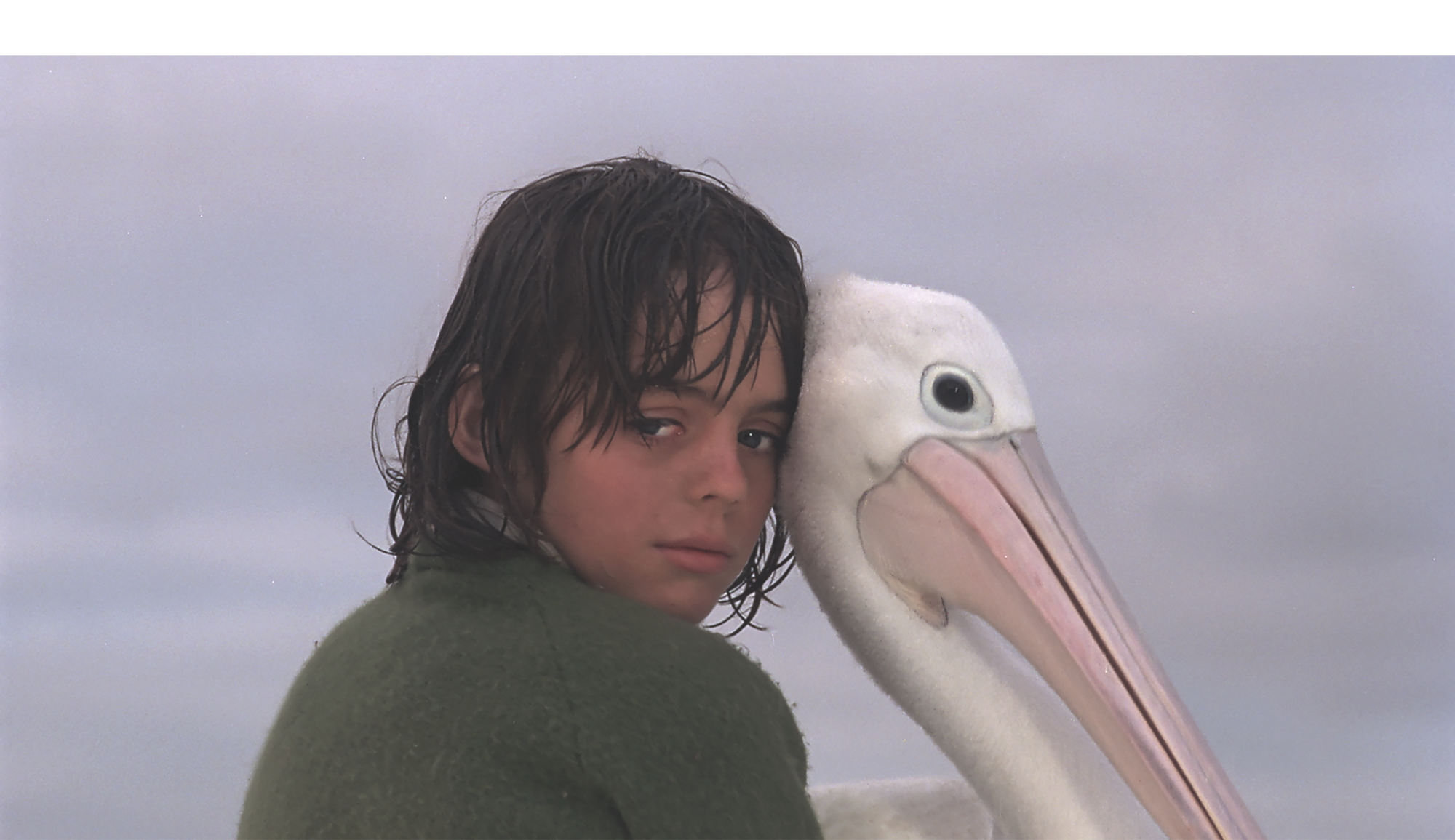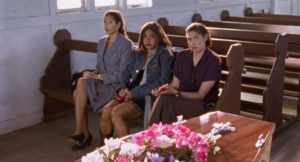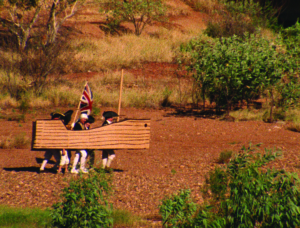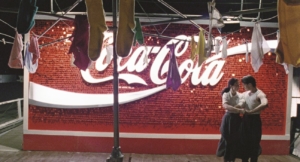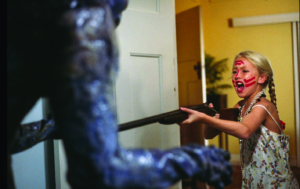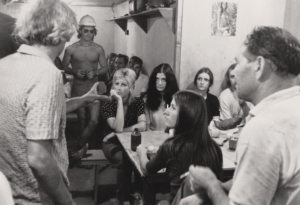In the musical Wonderful Town, in an awkward moment, trying to make conversation, Rosalind Russell said: ‘I was re-reading Moby Dick the other night …’ pause. ‘I haven’t picked that book up in years …’ still no response. ‘it’s worth picking up again.’ still no response. Desperately: ‘it’s about this whale.’[1]David Shipman, The Great Movie Stars: The Golden Years, Angus & Robertson, London, 1979, p. 492.
Substitute ‘film’ for ‘book’ and ‘pelican’ for ‘whale’, and you have something of both the media hype at the time of the making and screening of Storm Boy (Henri Safran, 1976) as well as the way in which memories of the film have lingered in a sort of collective Australian psyche: ‘It’s about this pelican.’
Not that any schoolchild of the late 1970s and early 1980s, particularly a South Australian one, would need reminding of Storm Boy or what it was about. To most schoolkids, Safran’s film was – according to media personality David Koch – the Harry Potter of its time.[2]David Koch, in ‘Where Is “Storm Boy” Greg Rowe Now?’, YouTube, 16 November 2008, <https://www.youtube.com/watch?v=zK_p-SLY9a0>, accessed 29 May 2018. Something of an exaggeration, given Potter was a kid-generated cult, and Storm Boy, a triumph of astutely targeted educational packaging and marketing, but there’s some grain of truth there.
So back to ‘this pelican’ – or, rather, pelicans, since the Mr Percival of the film was a composite of three different pelicans, each with different skill sets and temperaments. Mike ‘Storm Boy’ Kingley himself, Greg Rowe, said: ‘One was better at certain tricks than the others. Birds can be temperamental and if one was grumpy they would use another one.’[3]Greg Rowe, quoted in Gavin Lower & Verity Edwards, ‘Mr Percival Dips His Wings at 33’, The Australian, 4 September 2009. Scriptwriter Sonia Borg described these ‘skill sets’ as a major determinant in her adaptation of Colin Thiele’s novella:
I met the animal trainer [Gordon Noble] on Storm Boy and we talked about what the pelicans would be able to do. This influenced what I put in the script. I think it’s better to restrict oneself and only write down what is possible, rather than ask for the impossible.[4]Sonia Borg, quoted in ‘Storm Boy’, Ozmovies, <http://www.ozmovies.com.au/movie/storm-boy>, accessed 29 May 2018.
One thing pelicans will not do, however, is behave themselves at film premieres; as Noel Purdon recounts, ‘a plan to have them strolling elegantly in the foyer at the preview had to be dropped when the birds’ wild ways asserted themselves’[5]Noel Purdon, ‘Storm Boy’, Cinema Papers, issue 11, January 1977, p. 272. – ‘wild ways’ being, no doubt, a euphemism for another euphemism: ‘pelicans are not fastidious in their toilet habits’.[6]‘Storm Boy’, Ozmovies, op. cit. Producer Matt Carroll, recalling the beach shack in which the pelicans were raised, put it more pungently: ‘It stank! Pelican shit smells like rotting fish.’[7]Matt Carroll, quoted in Erin Free, ‘Taking Flight: The Making of Storm Boy’, FilmInk, 15 November 2016, <https://www.filmink.com.au/taking-flight-the-making-of-storm-boy/>, accessed 29 May 2018.
The pelicans’ habits, training and contrariness were the subject of constant media attention throughout filming. A double-page feature article in The Australian Women’s Weekly was entitled ‘Meet Dum Dum… Sandwich… and Carpenter… Stars of a New Film That Will Make Us All WATCH THE BIRDIES’.[8]Noel Rait, ‘Meet Dum Dum… Sandwich… and Carpenter… Stars of a New Film That Will Make Us All WATCH THE BIRDIES’, The Australian Women’s Weekly, 25 August 1976, pp. 48–9. The actors and the location played second billing to the real, avian ‘stars’. The completion – and the success – of their training session was reported in The Advertiser; readers learned that the pelicans had been taught to ‘be near people, to respond to simple signals and fly off holding an object in their beaks’. This was quite an achievement, since ‘their fear of humans usually makes them vomit as soon as they are approached’ – not to mention the propensity for the young chicks being reared for the film to go into a sort of epileptic feeding frenzy, which made using food as an incentive and a reward problematic.[9]‘Pelican Trio Gets Its Film Wings’, The Advertiser, 21 April 1976.
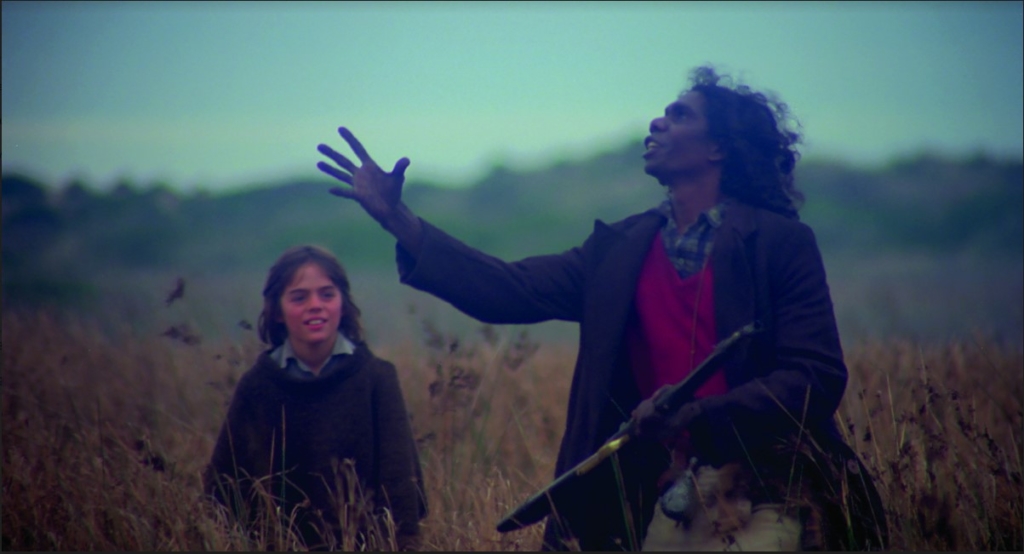
The birds’ waywardness was also featured in several media reports. Pelicans, readers discovered, have minds of their own. Dum Dum – the ‘trouble maker’ of the trio, it was reported – [10]‘Pelican Is a Flighty Star’, The Daily Telegraph, 23 June 1976.had flown off from his home base at the South Australian Film Corporation’s (SAFC) headquarters in Norwood to join a flock of pelicans at Goolwa. Previously, he had flown off and landed a ‘celebrity spot’ at a private party. On another occasion, he had gone walkabout in peak-period traffic. It could have been worse: Carroll recalled one instance on location when all three pelicans looked ready to take flight with their wild cousins. It was only quick thinking on the part of Noble that prevented this. He dispatched his dog to retrieve them, on the assumption that the wild birds would fly off and the trained pelicans, who had been imprinted at birth, would recognise the dog as their ‘mother’ (one of three, actually, the others being Noble and Rowe).[11]Free, op. cit.
And one pelican’s waywardness could have led not only to the cancellation of the project, but also to a media ‘scandal’ rivalling politician Barnaby Joyce’s ‘jobs for the girlfriend’. A$20,000 into the expenditure of the allotted A$320,000 budget, one of the pelicans was refusing to play its part, and the SAFC board considered cutting its losses. The film was saved by the eminently sensible suggestion of new board appointee Enid Peleska, an English and drama teacher, who admitted to knowing little about films but had a ‘gut feeling’ about the film’s potential … and about pelicans, presumably on the basis that, to the untrained eye, it’s difficult to tell one pelican from another. Her advice: ‘Get another pelican.’ Peleska, it was revealed recently, was the ‘secret former fiancee’ of then-premier Don Dunstan, who had appointed her to the board.[12]Roy Eccleston, ‘How Storm Boy Was Almost Dumped Thanks to a Pelican That Couldn’t Act’, News.com.au, 11 May 2017, <http://www.news.com.au/national/south-australia/how-storm-boy-was-almost-dumped-thanks-to-a-pelican-that-couldnt-act/news-story/ef71abc1386424819b9734ae5c4494ab>, accessed 29 May 2018.
Interest in the pelicans lingered long after the film. The death of Mr Percival, rechristened ‘Gringo’, rated ‘obituaries’ in both the Daily Telegraph[13]‘Feathered Star Dies’, The Daily Telegraph, 4 September 2009, p. 7. and The Australian when he died of old age in his thirties at the Adelaide Zoo, though it is disputed whether he was the last of the trio. In The Australian, zookeeper Brett Backhouse claimed that two other pelicans, ‘believed to be Mr Percival’s co-stars’, were ‘still alive and on show’.[14]Lower & Edwards, op. cit. Peleska had a point: if a zookeeper can’t tell the difference between one pelican and another, what hope is there for mere laypersons? But, in the immortal closing sentence of his text, Thiele says that ‘birds like Mr Percival do not really die’,[15]Colin Thiele, Storm Boy, New Holland Publishers, Sydney, 2017, p. 45. but simply go on existing in a sort of collective Australian consciousness. Reviewing Lucy Treloar’s historical fiction Salt Creek, Peter Pierce observed: ‘When we read of “a flock of pelicans flying in” we think, anachronistically, of Colin Thiele’s much loved novel of the Coorong’.[16]Peter Pierce, ‘Lucy Treloar, Salt Creek’, Meanjin, 2017, <https://meanjin.com.au/essays/lucy-treloar-salt-creek/>, accessed 29 May 2018.
Reviewers, too, were not immune to pelican charm. ‘There’s no way, for me at least, that the amazing Mr Percival is not the star of the movie,’ emoted the normally dry-eyed Geraldine Pascall. ‘On screen this pelican is a delightful creature that plays and snuggles and talks and loves and is so brave and constant […] you just care so much for that damn pelican.’[17]Geraldine Pascall, ‘The Summer Releases Roll with a Tear’, The Weekend Australian, 30–31 July 1977. ‘Square Eye’ certainly did: ‘You care about the boy and his Aboriginal friend and most of all you care about the pelican.’ Not since Casablanca (Michael Curtiz, 1942), he said, had he cared so much about the fate of characters in a film.[18]‘Square Eye’, ‘Local Film a Classic’, The Daily Mirror (Sydney), 20 October 1980. Even the curmudgeonly PP McGuinness succumbed:
The pelicans steal the show, of course. They are charming birds, and so well trained (with enormous difficulties) as to give the kind of impression of human characteristics which people are so fond of looking for in animals.[19]PP McGuiness, ‘Storm Boy: A Great Children’s Show for Adults’, The National Times, 1–6 August 1977.
And, writing in more recent times, Luke Buckmaster achieved a particular height of rhetorical giddiness, suggesting: ‘Thus begins probably the most loving portrait of a human being’s relationship with a pelican in cinema history.’[20]Luke Buckmaster, ‘Storm Boy Rewatched – Heartfelt Portrait of a Boy and His Pelican’, The Guardian, 21 November 2014, <https://www.theguardian.com/film/2014/nov/21/storm-boy-rewatched-heartfelt-portrait-of-a-boy-and-his-pelican>, accessed 29 May 2018.
Amid this many-headed pelican mania, it’s worth considering the intelligence of the unsung creators responsible for the composition of the film’s trailer.[21]Storm Boy trailer, available on YouTube, 24 August 2016, <https://www.youtube.com/watch?v=siKxwFpYEQc>, accessed 29 May 2018. They showed an understanding of the complex potency of the pelican through the four short images from which they chose to create a mosaic at the beginning of the trailer: a close-up of a pelican, Fingerbone’s (David Gulpilil) pelican-spirit dance and creation story, a vast squadron of pelicans taking flight from the lagoon, and the indiscriminate shooting of a pelican. Of the many possible pelican images, including the sure-fire ‘endearing’ ones, such as Mr Percival nestling his beak on Storm Boy’s neck, or the boy gambolling with the bird on the beach, the selected close-up instead showed a pelican, its neck extended, its wings outstretched. In one short take, the pelican’s spiritual significance in Aboriginal lore, its plenitude and the potential threat to its existence – humankind’s capacity for indiscriminate environmental vandalism – are all established.
The affectionate nature of the actors’ relationship is reflected in the film, in which Fingerbone becomes a sort of surrogate father to Storm Boy – the yang to the yin of his natural father. Both men are outsiders, but very differently so.
The film’s narrative may be, as Purdon put it, ‘boy meets pelican, boy loves pelican, boy finds new pelican’,[22]Purdon, op. cit. but its abiding subtext is firmly focused on the creature. The film is, for the trailer’s creators, not about this particular pelican, Mr Percival, but about the pelican, Pelecanus conspicillatus.
Skill sets and temperaments – the human kind
If the three pelicans brought different skill sets and temperaments to the avian protagonist, so did the actors who assumed the roles of the three major human characters. The reclusive, taciturn Tom ‘Hide-Away Tom’ Kingley was played by Peter Cummins, a leading figure in the Australian Performing Group, an iconic Australian drama collective based at the Pram Factory in Melbourne. In 1972, Cummins had played a very different kind of recluse: the poetically eloquent and garrulous Monk O’Neill in the premiere of Jack Hibberd’s play A Stretch of the Imagination; the playwright chose him for the role ‘because of his candour and inwardness as an actor’.[23]Jack Hibberd, quoted in Paul McGillick, Jack Hibberd, Rodopi, Amsterdam, 1988, p. 18. It’s this combination of qualities that The Age’s Paul Heinrichs noted as ‘fine understated’ playing of ‘an embittered, taciturn man who is escaping from sour experiences in the outside world’, which ‘giv[es] the character the right mixture of suppressed inner anguish which emerges as a sullen and slightly uncomprehending exterior’.[24]Paul Heinrichs, ‘Storm Boy a Thundering Success’, The Age, available at ‘Storm Boy’, Ozmovies, op. cit. The dialogue reinforces that impression. Take, for example, Cummins’ rendition of Hide-Away’s exchange with his son about the transistor radio that the latter scavenges on the beach. To the boy, it is a potential source of pleasure, a chance to listen to some music. To the father, it is a possible threat – the thin edge of the wedge of a ‘civilised’ world he has rejected, an enticement to a world of pain and delusion: ‘The radio will tell you this and that and a thousand other things. You’ll want more and more, and you’ll end up chasing a lot of rubbish.’
Cummins also drew on his inner Konstantin Stanislavski to create his character, utilising his experiences of solitary living while working as a young schoolteacher in Colac. Of that process, he said, ‘I think there is a loner in every man and I suppose the longer you’re around, the more courage you get to experiment.’[25]Peter Cummins, quoted in ‘Actor Fits Part of Loner in SA Film’, The Advertiser, 28 May 1976. He was not averse, either, to a bit of method experimentation on the set. In an interview for the National Film & Sound Archive of Australia, Rowe said that, at the end of the filming, Cummins apologised to him for his ‘distant and standoffish’ demeanour, which he had cultivated to ensure the tension between father and son that Borg had introduced into the narrative was sustained.[26]Greg Rowe, interview with the National Film & Sound Archive of Australia (NFSA), available at ‘Greg Rowe (Storm Boy) Looking Back 40 Years Later’, SoundCloud, 14 November 2016, <https://soundcloud.com/nfsaaustralia/greg-rowe-storm-boy-looking-back-40-years-later>, accessed 29 May 2018.
Just eleven years old at the time, Rowe also had a touch of the inner Stanislavski about him. Carroll recounted that he could do ‘sadness’ better than any of the 300-plus would-be Storm Boys. When asked to be ‘sad’, most of them thought of incidents in Thiele’s novella; in contrast, Rowe said, ‘I’m remembering when my grandma died. I loved her so much.’ The audition panel, Carroll recalled, ‘all bawled [their] eyes out’.[27]See Free, op. cit.
Rowe had come to the film via a modelling agency, which his sister had suggested he join. There is certainly a ‘model look’ about him – an ‘incongruous Don Dunstan prettiness’ – but, to Heinrichs, that perhaps came from the child actor managing to appear ‘like a little half-grown bird himself; skinny, big-eyed, sharp and alert, non-communicative’.[28]Heinrichs, op. cit. To this viewer, he has the look of one of those Dickensian street urchins in Carol Reed’s Oliver! (1968), a cross between Oliver (Mark Lester) and the Dodger (Jack Wild), transplanted to a wild Australian beach and suitably wind-whipped and tanned. Importantly, Rowe keeps at bay ‘the rampant cuteness of Disney animal kids and lends Storm Boy a sensitive and intelligent young face’.[29]Purdon, op.cit. And Rowe’s rapport with the various Mr Percivals, notwithstanding the occasional nip, was evident, as Carroll has explained:
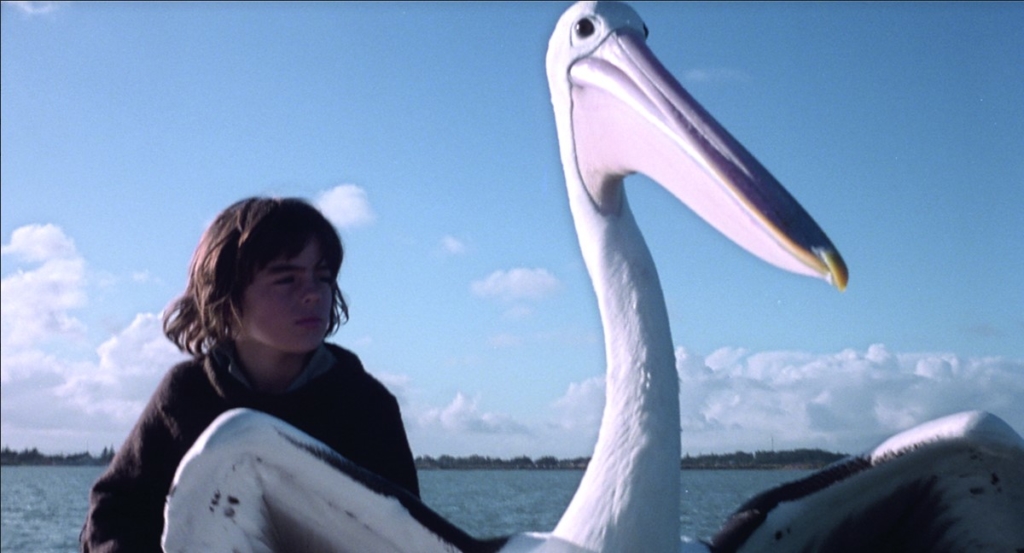
Greg was amazing because he really built up a great relationship with the pelicans even though he was frightened of them to begin with […] One of them bit him quite hard early on in filming, but eventually he grew very close to them and that particular scene, the two dancing down the beach, was a combination of their training and Greg’s ability to play with them and have a bit of fun with them. We were rolling and Greg just started to play with them and we kept it in the movie and it turned out to be one of those beautiful moments.[30]Matt Carroll, quoted in Amy Harris, ‘From Crocodile Dundee to Muriel’s Wedding, Top Moments in Aussie Film’, The Sunday Telegraph, 9 June 2013.
The rapport is most tellingly captured in a shot of bird and boy just before the latter is about to release the former and his companions into the wild, as ordered by his father. The bird drops its head and nuzzles up to the boy. To Heinrichs, the image ‘takes on a beautiful symmetry, the classic formula of triangular composition, which gives this sad moment an enormous emotional impact’.[31]Heinrichs, op. cit. It suggests also an instinctive spontaneous gesture on the part of the pelican that no amount of training might instil.
Enjoyable as the whole experience was, it left Rowe with little desire to become an actor, though he did work on a couple more films, including Blue Fin (Carl Schultz, 1978), which was written by Borg and executive-produced by Carroll. A long-term resident of Canada, Rowe now works as a squash coach. His most vivid memories of the filming are twofold: one was the coldness of the location, involving, for much of the four-week shoot, wintry days in the Coorong; the other was the camaraderie of the crew and cast, especially between him and Gulpilil.[32]Rowe, interview with the NFSA, op. cit.
If Cummins was ‘stand-offish’, in keeping with his character, Gulpilil’s natural warmth informed his relationship with Rowe on and off the screen. ‘The first time that I met him he just gave me a big hug and said, “I want you to call me ‘wooa’”,’ recounted Rowe, ‘which is an Aboriginal word for big brother, “and I’m going to call you ‘gooma’,” which means little brother.’[33]Greg Rowe, quoted in Free, op. cit. The affectionate nature of the actors’ relationship is reflected in the film, in which Fingerbone becomes a sort of surrogate father to Storm Boy – the yang to the yin of his natural father. Both men are outsiders, but very differently so: one, a recluse deliberately choosing to keep civilisation at bay; the other, an outcast from his community, and feeling the loneliness of that exclusion. But both are bonded by their love and concern for the boy, expressed in very distinct ways.
If Thiele was the spiritual godfather of Storm Boy, Carroll, as producer, was its passionate and very much hands-on practical genius – endlessly resourceful and inventive, from the film’s conception and creation, through to its extraordinary commercial success.
Coaxing Gulpilil to take the role in the production on the strength of his performance in Nicolas Roeg’s Walkabout (1971) took some effort on Carroll’s part. The actor, recalled the producer, had been somewhat traumatised by his experience on ‘the wild, booze-and-drug soaked production of Philippe Mora’s bizarre bushranger belter, Mad Dog Morgan [1976]’ and the behaviour of its ‘deranged American import’, Dennis Hopper. Storm Boy was a more satisfying experience for Gulpilil – not simply because of the scope of characterisation the script allowed him, but also because of Carroll’s trust in him: ‘I […] left David in charge of doing all the Aboriginal research, and he got involved with the local [I]ndigenous community.’[34]Carroll, quoted in Free, ibid.
Just as long as it’s not a sex comedy
Thiele, after some reservations, welcomed the adaptation of his novella, especially after Carroll informed him that it would actually be filmed in the Coorong, a world the author knew intimately and loved dearly. He signed on in a consultative capacity, but took a generous non-proprietorial attitude to the development of the script. His one stipulation, no doubt offered tongue-in-cheek, was that his text not be turned into a sex comedy.[35]Paul Davies, ‘Sonia Borg’, Cinema Papers, issue 18, October– November 1978, p. 109. The only addition Thiele was unhappy with – both in its conception and after viewing the film – was the dune-buggy sequence, an episode based on Carroll’s own experience camping out in the Coorong when he was disturbed by ‘the incongruous sounds of revving engines, churning sand, and booze-fuelled hollering’.[36]ibid.
Robert Ingpen, the illustrator for Storm Boy’s second edition and just as passionate about conservation as Thiele himself, said, of the dune-buggy episode, that the author actually ‘got cross, one of the few times I saw him cross’. Ingpen himself felt the film changed the ‘subtlety’ of Thiele’s message. One of the qualities he liked about Thiele was that his interest in conservation and the environment was not like a message
yelled at you by greenies or politicians […] I was fascinated with Colin and his storytelling, particularly the way he embraced the freshness with which humans look to their environment. He was writing about conservation in the days when we were only beginning to think about these things.[37]Robert Ingpen, quoted in Sonia Harford, ‘Storm Boy Illustrator Robert Ingpen on Bringing Colin Thiele’s Classic Book to Life, and Seeing It Adapted for the Stage’, The Sydney Morning Herald, 4 May 2015, <https://www.smh.com.au/entertainment/theatre/storm-boy-illustrator-robert-ingpen-on-bringing-colin-thieles-classic-book-to-life-and-seeing-it-adapted-for-the-stage-20150504-1mz92z.html>, accessed 29 May 2018.
On other matters, Thiele recognised that page and screen are different media when it comes to their emotional impacts: ‘You put a nine-metre by six-metre pelican up on a screen with shotgun blasts in its chest and it would have been quite horrifying.’[38]Colin Thiele, quoted in Valerie Hoogstad & Jennifer Simons, Storm Boy: The Making of a Film, Macmillan, South Melbourne, 1987, p. 6. Yet Borg – a German-born expat with a passion for the writings of Xavier Herbert, and living in what, to Carroll, felt like ‘a menagerie’ with ‘animals everywhere’[39]Carroll, quoted in Free, op. cit. – felt that her first responsibility was to the spirit of the text: ‘You must recreate what the author felt and it is therefore essential that you have the same outlook as the author.’[40]Sonia Borg, quoted in Davies, op. cit., p. 109. She and Thiele agreed that the operating philosophy of the book lay in the rather-bleak solace the father offers the boy when the latter asks the question, ‘Why did [the hunters] shoot […] Mr Percival?’: ‘[T]here will always be men who are cruel, just as there will always be men who are lazy or stupid or wise or kind. Today you’ve seen what cruel and stupid men can do.’[41]Thiele, Storm Boy, op. cit., p. 42.
With a background in children’s television and a number of small-screen credits – including Homicide, Matlock Police, Rush and Power Without Glory – under her belt, Borg welcomed the opportunity to write without some of the pressures demanded by commercial television. This industry would have expected her to linger over the shooters as ‘villains’, showing the men ‘stalking the birds and so on’ to build a sense of menace,[42]Borg, quoted in Davies, op. cit., p. 110. which would have been at odds with Thiele’s sense of the casual, gratuitous violence of their environmental vandalism. Oddly enough, however, when it came to the shooting of Mr Percival, Borg made a sort of reverse decision – and rightly so. In the novel, it is a deliberate act on the part of the shooters because Mr Percival has been warning other birds of the shooters’ presence; in her script, it is in keeping with everything we see about the offhand destructiveness of the hunters and of the sailors who mindlessly flick their beer cans into the water.
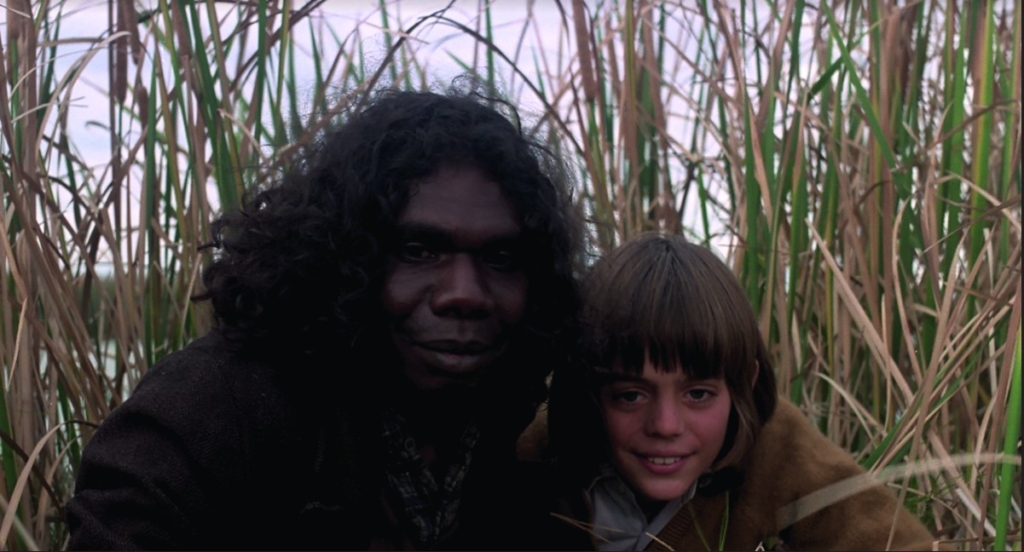
Nevertheless, it’s obvious that old writing habits die hard. Borg’s script eschews the languorous rhythms of Thiele’s text, in which the two main dramatic moments – the rescue of the ship’s crew during a fierce storm and the shooting of Mr Percival – come abruptly at the end. Instead, she creates a narrative that has several spaced dramatic ‘spikes’, which could well serve as the ‘to be continued’ climaxes of a TV miniseries; some of these are adapted from Thiele’s text but given more dramatic tension, and others were added by Borg. These are: the sudden appearance of Fingerbone, momentarily as a figure of fear; the shooting of the snake; Fingerbone’s gift of the book and his teaching Storm Boy to read; the return of Mr Percival after being released into the wild; Storm Boy overhearing the truth about his mother before running away to a mainland school; Fingerbone singing up a storm; the ship rescue, during which Mr Percival gets the dropping of the line in one attempt, rather than the ten he makes in the novella; and, of course, the shooting of Mr Percival.
More importantly, Borg made decisions that subtly changed the emotional dynamics of the text. One centres on the nature of the relationship between Storm Boy and his father; the other, the expanded role of Fingerbone in the narrative. Borg has reflected that the former had to be altered ‘because the film needed more development; we made the father a tougher character’.[43]ibid., p. 109. Certainly, in the novel, Hide-Away is a more benign presence, even towards the pelicans (‘Grandfather Pelican’, he calls himself as he grudgingly feeds them[44]Thiele, Storm Boy, op. cit., p. 16.), and there is no dissembling about his wife’s death. In contrast, Borg develops the father-son relationship in a way that allows for an emotional trajectory from detachment through estrangement to reconciliation.
The changes to Fingerbone’s presence are even more dramatic – and more dramatised. Thiele describes him as ‘a wiry, wizened man with a flash of white teeth and a jolly black face as screwed-up and wrinkled as an old boot’[45]ibid., p. 5. – hardly a description of Gulpilil’s Fingerbone, who steps lightly on the earth with a youthful physical grace, whether striding across sand dunes, wading through reeds, or doing his pelican dance on the beach. And Borg gives him more – and better – dialogue; one can hardly imagine Gulpilil’s Fingerbone saying, of the shooters, ‘By yimminy, I fill him with salt next time!’[46]ibid., p. 13. In the film, it is he, too, who gives Storm Boy his name because he ‘run like a blackfella, like the wind’ – unlike in the novel, in which the boy is so named by campers who see him ‘calm and happy’ in the eye of a storm.
The Coorong is a ‘lost’, ruined world because of the impact of European settlement and ignorance … Will the themes of conservation and environmentalism touched on so lightly and subtly by Thiele in 1964 be given stronger emphasis in a 2019 work?
Moreover, taking her cue from the text – ‘Before long Storm Boy had learnt enough to fill a hundred books’[47]ibid., p. 5. – Borg expands on Fingerbone’s role as mentor, teacher and friend to the boy. Whereas, in the novel, the emphasis is on him teaching Storm Boy about the natural world, she gives that education a more spiritual dimension as Fingerbone tells the story of the pelican’s origin. More importantly, he senses that the boy wants to know about a world elsewhere, a world beyond the Coorong; it’s as if Fingerbone has transformed the loneliness of his own outcast status into an empathetic understanding that, for the boy, this isolated life in the Coorong will not always ‘be the best place to be’, as Hide-Away asserts to his son’s slightly aggressive question, ‘Why do we live here?’ It is Fingerbone who gives Storm Boy the book and teaches him to read. And it is he, not his father, who convinces the boy to return home after he runs away to school.
It is Fingerbone, too, who complements Hide-Away’s rather-bleak attempt to console his son about Mr Percival’s death by asserting the fact that there are both kind and cruel men in the world. Fingerbone’s is a more optimistic consolation: in showing Storm Boy where he has buried the bird, then pointing to the newly hatched chick nearby, he offers the boy both a sense of closure for his grief and hope for renewal. And he does so by centring that wisdom in the rhythms and life cycles of the natural world: ‘Perhaps he’s another Mr Percival. Birds like him never die.’ This is a more dramatically satisfying and integral denouement to the narrative, I would suggest, than Thiele’s attempt at a sort of mystical pantheism that unites Storm Boy, at a boarding school in Adelaide, and his father, still at the humpy, in the encompassing embrace of a sort of giant pelican in the sky:
And always, above them, in their mind’s eye, they can see the shape of two big wings in the storm clouds and the flying scud – two wings of white with trailing black edges – spread across the sky. For birds like Mr Percival do not really die.[48]ibid., pp. 44–5.
Matt Carroll: producer, promoter, passionate
If Thiele was the spiritual godfather of Storm Boy, Carroll, as producer, was its passionate and very much hands-on practical genius – endlessly resourceful and inventive, from the film’s conception and creation, through to its extraordinary commercial success, both in Australia and internationally. Peter Rose, then–marketing director of the SAFC, even commented that Carroll ‘refused to accept the conventional wisdom of the industry (that children’s films were box-office poison)’.[49]Peter Rose, quoted in Russell Deiley, ‘Greg Takes the Film World by Storm’, The Daily Telegraph, 12 July 1977. Indeed, Carroll had a ready ally in the SAFC, which ‘had a gilt-edged reputation for taking unfashionable film themes and turning them into classic box-office winners’.[50]Deiley, ibid. It helped that he had previously produced another unconventional commercial success for the agency, Sunday Too Far Away (Ken Hannam, 1975).
It was Carroll who assuaged Thiele’s reservations through their mutual love of the Coorong. He sought out Borg as scriptwriter after rejecting a ‘dog’ of a script. He personally convinced Gulpilil to participate and, as stated previously, gave him considerable responsibilities in liaising with the local Indigenous community. He negotiated with South Australia’s National Parks and Wildlife Service for a gaggle of pelicans to train. The only carker for Carroll during the filming was the director, Henri Safran. The producer found him ‘a bit of an arrogant Parisian’;[51]Carroll, quoted in Free, op. cit. indeed, Safran found it disconcerting working with free-spirited, unconventional talents like Rowe and Gulpilil; temperamental, and occasionally recalcitrant, pelicans; a stuntman, Grant Page, doubling as a cameraman; and filming from hang-gliders – not to mention, presumably, Carroll himself.
Carroll’s inventiveness carried into the promotion of the film. Unable to persuade Village Roadshow to distribute what they saw as basically a kids film, he took up the suggestion of the company’s managing director, Greg Coote, to distribute the film himself. He hired the Fair Lady Theatre in Adelaide and started bussing students in to see the film, a strategy that continued for thirteen months. Thiele’s publisher, Rigby, printed new editions of the text with images from the film on the cover, and the author himself, in his educationalist role as director of Wattle Park Teachers’ College, ensured that Storm Boy was practically mandated reading and viewing for primary and junior secondary students. Not long after, with the arrival of VHS technology, children who were unable to see the film on the big screen could view it at school, their learning no doubt enhanced by the educational resources and kits produced by the South Australian education department’s Film Study Centre.
The film’s sales on its first weekend of exhibition – during which it grossed more than King Kong (John Guillermin, 1976) – astounded Village Roadshow, which eventually took over distribution in other states, using the same promotional strategies perfected by Carroll and the SAFC. In its first eight months, at the Adelaide box office alone, the film grossed A$300,000.[52]‘Storm Boy’, Ozmovies, op.cit.
Storm Boy won the Australian Film Institute’s Best Film award in 1977, and its international success was just as phenomenal, winning awards and acclaim in Tehran and Moscow, and screening in over 100 countries. Royalty – including Japan’s then-emperor Hirohito and Queen Elizabeth, who viewed it on the royal yacht Britannia – requested private screenings, as did then–US president Jimmy Carter, apparently as the result of assiduous lobbying by South Australian opposition leader David Tonkin. When it came to promoting such a distinctively South Australian product, political bipartisanship ruled.[53]Ted Knetz, ‘South Australian Film Is on the White House Viewing List’, The Australian, 8 February 1977.
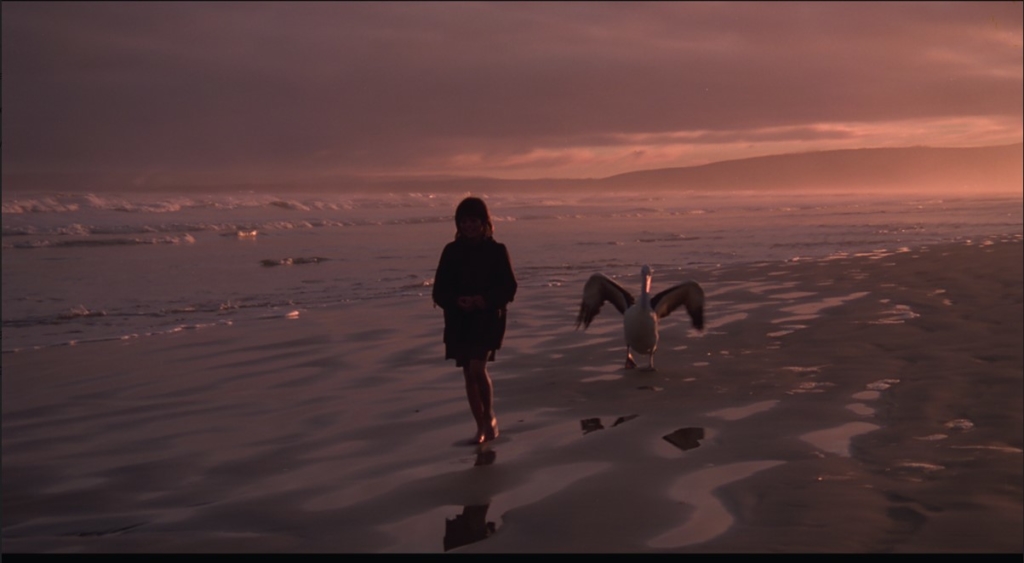
Not a Disney film
As far as the critics were concerned, there seemed to be a collective sigh of relief that the film was not like a Disney film. Los Angeles critic Kevin Thomas thought it ‘the kind of picture Disney should be making but so seldom does. It’s a family film with an unflinching yet positive grip on reality.’[54]Kevin Thomas, ‘Lessons of Life in Storm Boy’, Los Angeles Times, 17 November 1981. For London Daily Telegraph critic Eric Shorter, Storm Boy was comparable to Ken Loach’s Kes (1969) ‘in its perception of the boy’s loneliness and love of pets – and it [wasn’t] without its polemical moments of social criticism, either’.[55]Eric Shorter, ‘Storm Boy Best at Moscow’, The Australian, 15 July 1977. In later years, the film has been described as ‘Australia’s answer to Free Willy [Simon Wincer, 1993] and E.T. [the Extra-Terrestrial, Steven Spielberg, 1982]’ in the way it ‘emotively celebrates an unconventional friendship – minus the super serve of cheese’.[56]Buckmaster, op. cit.
We can only speculate as to what a Disney version might have been like, though there is perhaps a clue in the cloyingly sentimental ballad[57]See ‘David Soul – Storm Boy – Starsky & Hutch’, YouTube, 19 March 2008, <https://www.youtube.com/watch?v=19X41EMEDeY>, accessed 29 May 2018. that Starsky and Hutch’s David Soul and Leslie Bricusse wrote, at the request of the SAFC, as a possible ‘hook’ for the British and American markets.[58]‘David Puts Soul into Storm Boy’, The Australian, 9 January 1978. Soul himself had been impressed by the film when he saw it as a Christmas special on BBC television, and did not charge for his services. The song offers variations on the ‘life lessons’ that Storm Boy will learn about kindness and cruelty, friends and foes, including this piece of warbled banality: ‘she’ll drop you on your head, then she’ll smile, blow a kiss’ because ‘life is a woman’. As for the pelican … what pelican? This music is so different in mood and tone from Michael Carlos’ spare, understated score, which allowed space for the sounds of the natural life of the Coorong (birds, water, storms) and the human sounds of outboard motors and dune buggies, and trusted in stretches of silence. Yet the film’s appearance on BBC television was a sign of the SAFC and Carroll’s promotional ingenuity. Having failed to find a British distributor, they sold it to the BBC for A$75,000 for a single viewing. It was viewed by over 4 million people. A repeat performance during Easter was viewed by 9 million.
The Age’s John Hindle resisted the lure of the pelicans and thought the ‘real star’ of the film was the Coorong itself.[59]John Hindle, ‘Great for Kids, Adults’, Green Guide, The Age, 15 March 1984. Many critics concurred, and singled out Geoff Burton’s cinematography as one of the film’s significant achievements, especially in its evocation of the landscape (Burton won the 1977 Australian Cinematographers Society’s Milli Award for his work). In a similar vein, Heinrichs wrote:
Burton’s camera explores and exploits the differing textures, the sense of space and the changing moods of sand, sea and sky. Some shots are close-ups, others wide vistas taken from the air, and the juxtaposition is well edited. Water becomes a still mirror reflecting a Turneresque play of light, an opaque presence on a window pane, a rippling pattern spreading before a speeding boat, a surging foam to churn up excitement.[60]Heinrichs, op. cit.
Purdon agreed, commenting on the ways in which the cinematography gives ‘the winter landscape and seascapes an almost surreal space and presence’. He was particularly taken by the way ‘a tellingly ominous gloom is achieved in the sequence of two boats putting out from [Goolwa] in the evening light’,[61]Purdon, op. cit. a sequence accompanied by Fingerbone’s ominous singing.
The film was not without its critics, who had reservations about what the overall achievement – worthy as it was – might be. David Stratton found the last third of the film ‘banal’;[62]David Stratton, The Last New Wave; The Australian Film Revival, cited in ‘Storm Boy’, Ozmovies, op. cit. he probably had in mind the extended school sequence, prompted by Storm Boy overhearing his father ‘lie’ about his mother’s death. It certainly slows the pace of the film’s movement as embedded in the rhythms of Coorong life, but does not, I think, skew or distort its thematic concerns. The sequence enables Borg to reinforce ideas she had developed throughout the narrative: Storm Boy’s unspoken desire for community as he looks longingly through the school’s wire fence at kids at play; the contrast between Storm Boy and the schoolchildren, his comparative freedom compared with their penned-in environment; Storm Boy’s experiential learning about pelicans in his conversations with Fingerbone contrasted with the schoolchildren’s ‘chalk and talk’ learning about them as they sit in serried silence.
The sequence also reinforces the image of the schoolteacher (Judy Dick) – previously seen with the ranger (Tony Allison) when politely questioning Hide-Away about Storm Boy’s homeschooling – as benignly concerned about Storm Boy’s wellbeing. And perhaps the fact that the class happens to be learning about pelicans is not just a happy coincidence. The teacher uses it to add another dimension to Mr Percival’s persona – his nobility – in her explanation of Sir Percival as one of the heroic (though, in some accounts, ill-fated) knights of the Round Table. In recent years, this portrait of the teacher (and the ranger) even moved one YouTube user to lament a lost idyllic Australia where government authority was less intrusive in people’s lives: ‘wow how much Australia has changed to an overregulated nanny state CPS would stick their noses in in an instant, the child would be made ward of the state, the humpy bulldozed!’[63]See the comment by user ‘roobyduuby’ in ‘STORMBOY PT1 1976’, YouTube, 19 July 2009, <https://www.youtube.com/watch?v=cefU7uRtEbg>, accessed 29 May 2018.
Impressive as the evocation of the landscape was for Purdon, he felt the film did not do justice to the Coorong, which he deemed ‘a thousand times more strange and full of moods than the film manages to convey’.[64]Purdon, op. cit. Certainly, the film does not quite capture the maniacal savagery of the storm in Thiele’s writing:
Shrieking and raging out of the south, the Antarctic winds seemed to have lost themselves and come up howling in a frenzy to find the way […] they flattened the sedge, rooted out some of the bushes that had crouched on top of the sandhills for years, and blew out one of the iron sheets from the humpy […] In July the winds lost their senses. Three great storms swept out of the south, the third one so terrible that it gathered up the sea in mountains, mashed it into foam, and hurled it against the shore. The waves came in like rolling railway embankments right up to the sandhills where Hide-Away and Storm Boy lived.[65]Thiele, Storm Boy, op. cit., p. 29.
As well, the Coorong’s Indigenous connections and history, as distinct from Gulpilil’s Aboriginal presence, are underutilised, despite Thiele’s ‘invitation’ in his text to make use of such. The discovery of the midden leads his Fingerbone to lament: ‘Dark people eat, make camp, long time ago […] No whitefellow here den. For hundreds and hundreds of years, only blackfellows.’[66]ibid., p. 9.
Purdon sheets the film’s limitations home to a failure of imagination on the part of Safran – ‘a good employee but no poet’, a journeyman when the film was crying out for an auteur (such as Peter Weir) possessed of a kinship with the film’s rich materials and a sense of cinematic adventurousness in exploiting and enhancing those materials.[67]Purdon, op. cit.
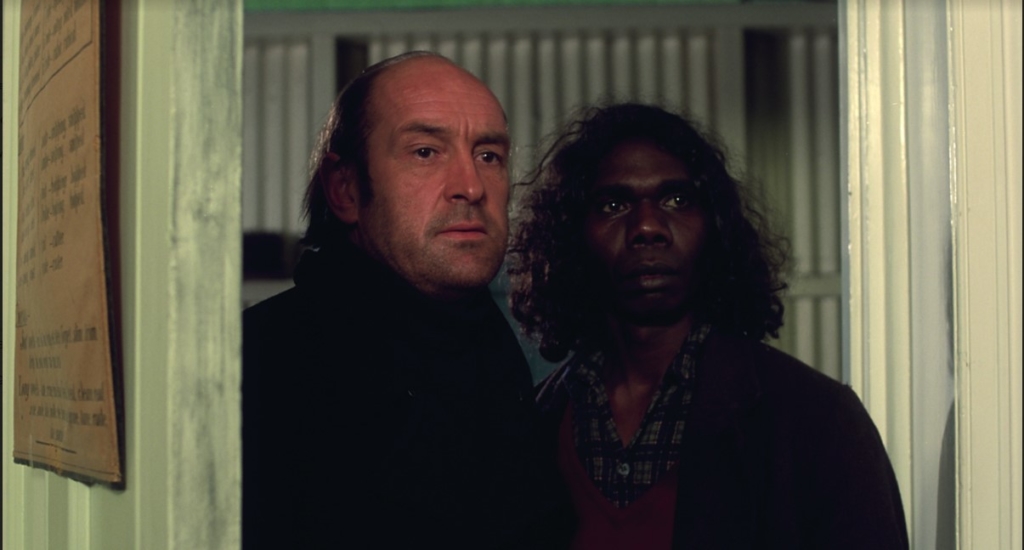
Mr Percival flies again: Storm Boy, Mark II
And now we have the new Storm Boy, written by Justin Monjo and directed by Shawn Seet, due for release in 2019. Geoffrey Rush – who plays an older Mike Kingley, now a highly successful businessman and a grandfather – promises us ‘a beautiful, fresh evocation of Colin Thiele’s original 1950s setting’.[68]Geoffrey Rush, quoted in Isabel Dayman, ‘Storm Boy Remake with Actor Geoffrey Rush About to Start Filming in SA Coorong’, ABC News, 26 July 2017, <http://www.abc.net.au/news/2017-07-26/storm-boy-remake-with-geoffrey-rush-to-start-coorong-filming/8746236>, accessed 29 May 2018.
The Screen Guide on the Screen Australia website offers the following synopsis of the new version:
When a highly successful retired businessman, Michael Kingley, starts to see things he at first can’t explain, his life takes a dramatic turn. And when his granddaughter rebels against her father, he is forced to re-evaluate his life and to act to prevent her going down a similar path to one he took years before. He tells her his story, when as a boy he lived a lonely existence with his father, Hideaway Tom, on an isolated coastline and how a bond with an orphaned pelican, Mr. Percival, changed his life forever.[69]‘Storm Boy’, The Screen Guide, Screen Australia, <https://www.screenaustralia.gov.au/the-screen-guide/t/storm-boy-2018/35536/>, accessed 29 May 2018.
With such a complex overlay of generational tension, of past and future, of time and the play of memory, one wonders if ‘boy meets pelican, boy loves pelican, boy meets new pelican’ will be reduced to a subplot. Will the presence of a rebellious granddaughter give the film a feminist perspective? Do wayward twenty-first century female teenagers require different kinds of ‘life lessons’ from the ones a ten-year-old boy learnt all those years ago?
Undoubtedly, CGI technology will offer a more dramatically exciting ship rescue and a storm to match the ferocity of Thiele’s. Nevertheless, one still has a sneaking admiration for the technical ingenuity of that sequence in the 1976 version: filmed on a reef near the mouth of the Murray; a boat moored in sheltered water at the end of a long pier; shot in ways that made the boat look farther away than it actually was; the waves breaking on the reef, whipped into a tumult of sorts by an assortment of wind machines and outboard motors![70]Hoogstad & Simons, op. cit., p. 47. One thing is certain: there will be no spoiling glimpse of the wingtip of Page’s hang-glider as he filmed, from above, the flight of a squadron of pelicans in the 1976 adaptation’s closing shot.
But what of the pelicans? Will their presence and their feats be CGI-enhanced? Will they do more than honk and skid and waddle and soar? Not that pelicans ever ‘honked’ – that was a triumph of early computer technology, introduced to make Mr Percival a ‘talking’ pelican that could demonstrate the kind of human characteristics that, McGuinness suggested, people look for in animals.[71]McGuinness, op. cit. To create the ‘honks’, Carlos used a Fairlight CMI synthesiser to invent a ‘voice’ and a basic language of ‘yes’, ‘no’, ‘maybe’ and ‘look at me’ for Mr Percival by blending duck and other wildlife sounds with musical instruments.[72]Free, op. cit.
There are serious questions, as well, that need to be asked of any twenty-first century creative work to be set in the Coorong, whatever the period in which the work is set. These are issues implicitly raised by Treloar in her novel’s acknowledgements:
The Coorong is strange and secluded and grand enough to humble, though the sensation of remoteness experienced when visiting it is these days a trick of geography and landscape rather than distance. The traditional custodians of the land, the Ngarrindjeri, inhabited this once almost unimaginably rich region with great sensitivity for millennia; many live there still, working towards its restoration. In some ways Salt Creek is a lament for that lost world.[73]Lucy Treloar, Salt Creek, Picador, Sydney, 2015, p. 403.
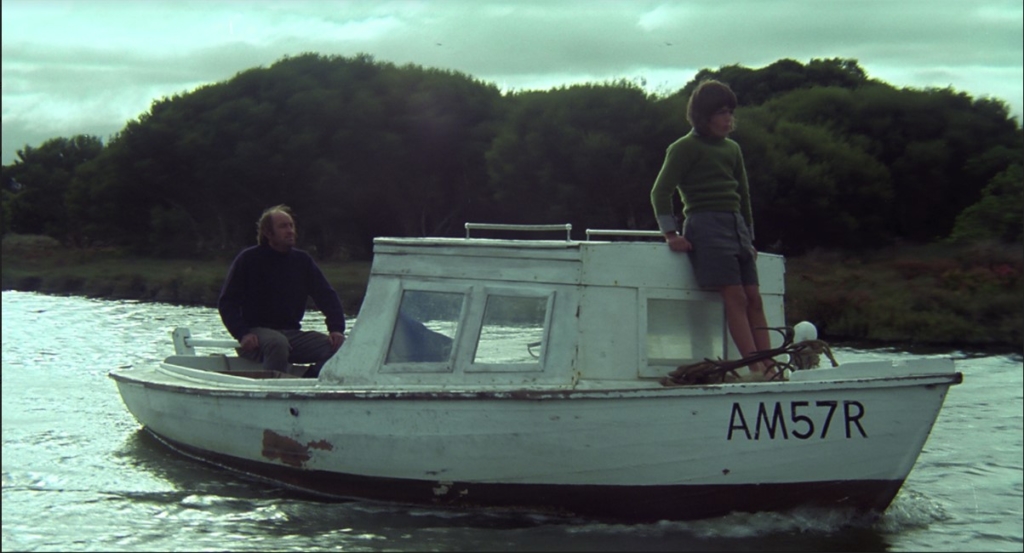
The Coorong is a ‘lost’, ruined world because of the impact of European settlement and ignorance. (There is even an underlying hint of melancholic awareness of such in Carlos’ musical score.) Will the themes of conservation and environmentalism touched on so lightly and subtly by Thiele in 1964 be given stronger emphasis in a 2019 work, precisely because the issues have become much more urgent and more foregrounded in public consciousness? The South Australian Government, in contributing A$500,000 to the film, certainly hoped it would have a propaganda thrust ‘to make the rest of Australia, and the rest of the world, aware of the unique environment we have in the Coorong and how important the protection of the Murray-Darling Basin is’[74]Jack Snelling, quoted in Dayman, op.cit. – though some think that the damage to the Coorong is beyond repair, evident in mass extinctions and breeding declines, despite there having been a ‘bird boom’ in 2016.[75]Dave Crewe, ‘Storm Boy: Cheat Sheet’, SBS Movies, 1 December 2016, <https://www.sbs.com.au/movies/article/2016/12/01/storm-boy-cheat-sheet>, accessed 29 May 2018.
And what of the ‘traditional custodians of the land’, the Ngarrindjeri – how should they be portrayed in a reimagining of Storm Boy in 2019? They are not mentioned in Thiele’s text nor Borg’s script, though Thiele’s Fingerbone could be a member of that community. He has no past history in the text; he is simply ‘there’. Borg’s adaptation, in contrast, requires Fingerbone to be not of the local tribe – he is an outcast from the Kurnai tribe, which, today, raises questions about how the Ngarrindjeri might have reacted to the presence of an Indigenous stranger camping in their territory. Borg’s conception of Fingerbone – immeasurably assisted by Gulpilil’s assured and authoritative playing of him – is, all critics agree, an impressive achievement. His outcast status has allowed her to explore dramatic tensions between his sense of himself as an outsider and Hide-Away’s. His wisdom is the moral centre of the narrative, not only in his understanding of the rhythms of the natural world, which enables him to bring some sense of closure to Storm Boy’s grief, but also in his instinctive understanding of a human need for community: ‘No good on your own.’
But the creation of his personal story is the result of a European’s intelligent and empathetic research of a generic history of Indigenous peoples and the sorry story of their contact with white settlement. He is an outcast because he has transgressed tribal law. He has had ‘the bone pointed’ at him because of his illicit relationship with a woman. The woman, the script casually hints, has become an outcast as well, a city ‘fringe-dweller’, now living with a white man. Borg’s Fingerbone went to mission school, where he learnt to read, and worked on a cattle station. His story of the creation of the pelican is a tale from the Kurnai people (from Gippsland), but the dance with which he chooses to celebrate the pelican’s spirit is from the Ganalbingu people (from the Northern Territory).
It is a creative problem Borg seems to have been aware of – and more so the further her career took her into researching and writing about Indigenous peoples and their histories. By 1978, she was researching the lives of Aboriginal women for a TV series she was co-authoring with Hyllus Maris, which eventually became Women of the Sun. ‘I started to discover what Aboriginals have said about themselves,’ she said, of her research. ‘I read [K]ath Walker’s [now Oodgeroo Noonuccal] poems, and a couple of books by [Katharine Susannah] Prichard. I can see quite a big difference: one speaks from the inside, the other as an outsider.’[76]Borg, quoted in Davies, op. cit., p. 162. By this criterion, her Fingerbone is more Prichard than Noonuccal. Will the 2019 Fingerbone Bill (Trevor Jamieson) be an ‘insider’ creation with a genuine Indigenous voice and presence?
Finally, what of the intended audience, the current generation of filmgoers who have been brought up on the seemingly never-ending Star Wars movies, Marvel superheroes, Pixar animations, and assorted CGI hobbits, orcs, goblins and dragons? Will they flock to Storm Boy Mark II? The success of recent Australian films such as Red Dog (Kriv Stenders, 2011) and Oddball (Stuart McDonald, 2015) suggests they will. And it won’t simply be children – in retrospect, the 1976 Storm Boy was never really a children’s film. It is an exemplary example of that ‘crossover’ genre: the children’s film that adults enjoy. McGuinness recommended it as such: ‘Sensitive parents who take their children will not have to shrivel up in their seats in embarrassment or take to drink. You don’t even have to be a parent to enjoy it.’[77]McGuinness, op. cit.
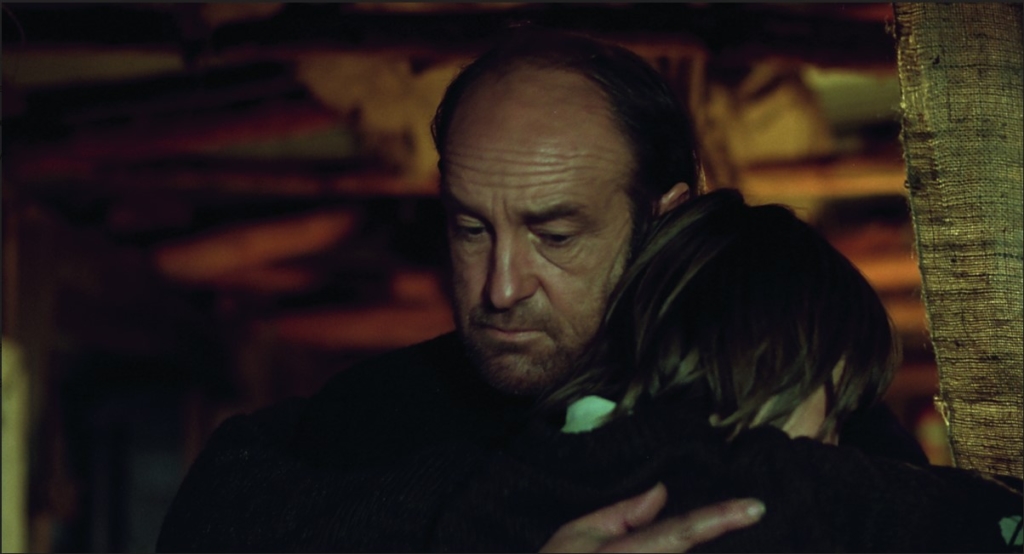
For what my personal testimony is worth, I recently took several grandkids to a screening of A Dog’s Purpose (Lasse Hallström, 2017)at my local cinema, the Sun Theatre in Yarraville. There were kids aplenty, but they were outnumbered by adults … and dogs, which had been brought along by their owners for a ‘special treat’. The screening was an example of the entrepreneurial acumen of the cinema owner, Michael Smith, an acumen that surely rivals Carroll’s ability to ‘market’ a film. Smith’s theatre has run twenty-four-hour marathon screenings of the Harry Potter series; a singalong session of The Greatest Showman (Michael Gracey, 2017); a ‘surprise’ appearance by Quentin Tarantino, Samuel L Jackson and Kurt Russell at a screening of the 70mm version of Tarantino’s The Hateful Eight (2015). Smith’s own tiny amphibious flying plane was even parked in the theatre’s adjacent pop-up park to advertise Voyage of the Southern Sun (Robert Murphy, 2017), a documentary tracing historical airmail routes of the 1930s. Who knows – we may yet see pelicans, if not in the foyer, then certainly in the pop-up park, no doubt asserting their ‘wild ways’.
https://clickv.ie/w/metro/storm-boy
This article has been refereed.
Select bibliography
Paul Davies, ‘Sonia Borg’, Cinema Papers, issue 18, October– November 1978, pp. 109–11, 162.
Erin Free, ‘Taking Flight: The Making of Storm Boy’, FilmInk, 15 November 2016, <https://www.filmink.com.au/taking-flight-the-making-of-storm-boy/>, accessed 29 May 2018.
Valerie Hoogstad & Jennifer Simons, Storm Boy: The Making of a Film, Macmillan, South Melbourne, 1987.
Noel Purdon, ‘Storm Boy’, Cinema Papers, issue 11, January 1977, p. 272.
‘Storm Boy’, Ozmovies, <http://www.ozmovies.com.au/movie/storm-boy>, accessed 29 May 2018.
Colin Thiele, Storm Boy, New Holland Publishers, Sydney, 2017 [1963].
MAIN CAST
Storm Boy Greg Rowe Hide-Away Tom Peter Cummins Fingerbone David Gulpilil Miss Walker Judy Dick Ranger Tony Allison Boat Master Michael Moody Edwards Graham Dow Jones Eric Mack Lynch Frank Foster-Brown Hunters Michael Caulfield, Paul Smith Marina Manager Hedley Cullen Schoolchildren from Port Elliot Primary School
PRINCIPAL CREDITS
Year of release 1976 Length 88 minutes Producer Matt Carroll (for the South Australian Film Corporation) Director Henri Safran Screenplay Sonia Borg, from the novel by Colin Thiele Associate Producer Jane Scott Cinematography Geoff Burton Editor G Turney-Smith Sound Ken Hammond Music Michael Carlos Production Design David Copping Technical Advisor Grant Page Pelican Trainer Gordon Noble Make-up / Wardrobe Helen Dyson Wardrobe Assistant Jennifer Zadow
Endnotes
| 1 | David Shipman, The Great Movie Stars: The Golden Years, Angus & Robertson, London, 1979, p. 492. |
|---|---|
| 2 | David Koch, in ‘Where Is “Storm Boy” Greg Rowe Now?’, YouTube, 16 November 2008, <https://www.youtube.com/watch?v=zK_p-SLY9a0>, accessed 29 May 2018. |
| 3 | Greg Rowe, quoted in Gavin Lower & Verity Edwards, ‘Mr Percival Dips His Wings at 33’, The Australian, 4 September 2009. |
| 4 | Sonia Borg, quoted in ‘Storm Boy’, Ozmovies, <http://www.ozmovies.com.au/movie/storm-boy>, accessed 29 May 2018. |
| 5 | Noel Purdon, ‘Storm Boy’, Cinema Papers, issue 11, January 1977, p. 272. |
| 6 | ‘Storm Boy’, Ozmovies, op. cit. |
| 7 | Matt Carroll, quoted in Erin Free, ‘Taking Flight: The Making of Storm Boy’, FilmInk, 15 November 2016, <https://www.filmink.com.au/taking-flight-the-making-of-storm-boy/>, accessed 29 May 2018. |
| 8 | Noel Rait, ‘Meet Dum Dum… Sandwich… and Carpenter… Stars of a New Film That Will Make Us All WATCH THE BIRDIES’, The Australian Women’s Weekly, 25 August 1976, pp. 48–9. |
| 9 | ‘Pelican Trio Gets Its Film Wings’, The Advertiser, 21 April 1976. |
| 10 | ‘Pelican Is a Flighty Star’, The Daily Telegraph, 23 June 1976. |
| 11 | Free, op. cit. |
| 12 | Roy Eccleston, ‘How Storm Boy Was Almost Dumped Thanks to a Pelican That Couldn’t Act’, News.com.au, 11 May 2017, <http://www.news.com.au/national/south-australia/how-storm-boy-was-almost-dumped-thanks-to-a-pelican-that-couldnt-act/news-story/ef71abc1386424819b9734ae5c4494ab>, accessed 29 May 2018. |
| 13 | ‘Feathered Star Dies’, The Daily Telegraph, 4 September 2009, p. 7. |
| 14 | Lower & Edwards, op. cit. |
| 15 | Colin Thiele, Storm Boy, New Holland Publishers, Sydney, 2017, p. 45. |
| 16 | Peter Pierce, ‘Lucy Treloar, Salt Creek’, Meanjin, 2017, <https://meanjin.com.au/essays/lucy-treloar-salt-creek/>, accessed 29 May 2018. |
| 17 | Geraldine Pascall, ‘The Summer Releases Roll with a Tear’, The Weekend Australian, 30–31 July 1977. |
| 18 | ‘Square Eye’, ‘Local Film a Classic’, The Daily Mirror (Sydney), 20 October 1980. |
| 19 | PP McGuiness, ‘Storm Boy: A Great Children’s Show for Adults’, The National Times, 1–6 August 1977. |
| 20 | Luke Buckmaster, ‘Storm Boy Rewatched – Heartfelt Portrait of a Boy and His Pelican’, The Guardian, 21 November 2014, <https://www.theguardian.com/film/2014/nov/21/storm-boy-rewatched-heartfelt-portrait-of-a-boy-and-his-pelican>, accessed 29 May 2018. |
| 21 | Storm Boy trailer, available on YouTube, 24 August 2016, <https://www.youtube.com/watch?v=siKxwFpYEQc>, accessed 29 May 2018. |
| 22 | Purdon, op. cit. |
| 23 | Jack Hibberd, quoted in Paul McGillick, Jack Hibberd, Rodopi, Amsterdam, 1988, p. 18. |
| 24 | Paul Heinrichs, ‘Storm Boy a Thundering Success’, The Age, available at ‘Storm Boy’, Ozmovies, op. cit. |
| 25 | Peter Cummins, quoted in ‘Actor Fits Part of Loner in SA Film’, The Advertiser, 28 May 1976. |
| 26 | Greg Rowe, interview with the National Film & Sound Archive of Australia (NFSA), available at ‘Greg Rowe (Storm Boy) Looking Back 40 Years Later’, SoundCloud, 14 November 2016, <https://soundcloud.com/nfsaaustralia/greg-rowe-storm-boy-looking-back-40-years-later>, accessed 29 May 2018. |
| 27 | See Free, op. cit. |
| 28 | Heinrichs, op. cit. |
| 29 | Purdon, op.cit. |
| 30 | Matt Carroll, quoted in Amy Harris, ‘From Crocodile Dundee to Muriel’s Wedding, Top Moments in Aussie Film’, The Sunday Telegraph, 9 June 2013. |
| 31 | Heinrichs, op. cit. |
| 32 | Rowe, interview with the NFSA, op. cit. |
| 33 | Greg Rowe, quoted in Free, op. cit. |
| 34 | Carroll, quoted in Free, ibid. |
| 35 | Paul Davies, ‘Sonia Borg’, Cinema Papers, issue 18, October– November 1978, p. 109. |
| 36 | ibid. |
| 37 | Robert Ingpen, quoted in Sonia Harford, ‘Storm Boy Illustrator Robert Ingpen on Bringing Colin Thiele’s Classic Book to Life, and Seeing It Adapted for the Stage’, The Sydney Morning Herald, 4 May 2015, <https://www.smh.com.au/entertainment/theatre/storm-boy-illustrator-robert-ingpen-on-bringing-colin-thieles-classic-book-to-life-and-seeing-it-adapted-for-the-stage-20150504-1mz92z.html>, accessed 29 May 2018. |
| 38 | Colin Thiele, quoted in Valerie Hoogstad & Jennifer Simons, Storm Boy: The Making of a Film, Macmillan, South Melbourne, 1987, p. 6. |
| 39 | Carroll, quoted in Free, op. cit. |
| 40 | Sonia Borg, quoted in Davies, op. cit., p. 109. |
| 41 | Thiele, Storm Boy, op. cit., p. 42. |
| 42 | Borg, quoted in Davies, op. cit., p. 110. |
| 43 | ibid., p. 109. |
| 44 | Thiele, Storm Boy, op. cit., p. 16. |
| 45 | ibid., p. 5. |
| 46 | ibid., p. 13. |
| 47 | ibid., p. 5. |
| 48 | ibid., pp. 44–5. |
| 49 | Peter Rose, quoted in Russell Deiley, ‘Greg Takes the Film World by Storm’, The Daily Telegraph, 12 July 1977. |
| 50 | Deiley, ibid. |
| 51 | Carroll, quoted in Free, op. cit. |
| 52 | ‘Storm Boy’, Ozmovies, op.cit. |
| 53 | Ted Knetz, ‘South Australian Film Is on the White House Viewing List’, The Australian, 8 February 1977. |
| 54 | Kevin Thomas, ‘Lessons of Life in Storm Boy’, Los Angeles Times, 17 November 1981. |
| 55 | Eric Shorter, ‘Storm Boy Best at Moscow’, The Australian, 15 July 1977. |
| 56 | Buckmaster, op. cit. |
| 57 | See ‘David Soul – Storm Boy – Starsky & Hutch’, YouTube, 19 March 2008, <https://www.youtube.com/watch?v=19X41EMEDeY>, accessed 29 May 2018. |
| 58 | ‘David Puts Soul into Storm Boy’, The Australian, 9 January 1978. |
| 59 | John Hindle, ‘Great for Kids, Adults’, Green Guide, The Age, 15 March 1984. |
| 60 | Heinrichs, op. cit. |
| 61 | Purdon, op. cit. |
| 62 | David Stratton, The Last New Wave; The Australian Film Revival, cited in ‘Storm Boy’, Ozmovies, op. cit. |
| 63 | See the comment by user ‘roobyduuby’ in ‘STORMBOY PT1 1976’, YouTube, 19 July 2009, <https://www.youtube.com/watch?v=cefU7uRtEbg>, accessed 29 May 2018. |
| 64 | Purdon, op. cit. |
| 65 | Thiele, Storm Boy, op. cit., p. 29. |
| 66 | ibid., p. 9. |
| 67 | Purdon, op. cit. |
| 68 | Geoffrey Rush, quoted in Isabel Dayman, ‘Storm Boy Remake with Actor Geoffrey Rush About to Start Filming in SA Coorong’, ABC News, 26 July 2017, <http://www.abc.net.au/news/2017-07-26/storm-boy-remake-with-geoffrey-rush-to-start-coorong-filming/8746236>, accessed 29 May 2018. |
| 69 | ‘Storm Boy’, The Screen Guide, Screen Australia, <https://www.screenaustralia.gov.au/the-screen-guide/t/storm-boy-2018/35536/>, accessed 29 May 2018. |
| 70 | Hoogstad & Simons, op. cit., p. 47. |
| 71 | McGuinness, op. cit. |
| 72 | Free, op. cit. |
| 73 | Lucy Treloar, Salt Creek, Picador, Sydney, 2015, p. 403. |
| 74 | Jack Snelling, quoted in Dayman, op.cit. |
| 75 | Dave Crewe, ‘Storm Boy: Cheat Sheet’, SBS Movies, 1 December 2016, <https://www.sbs.com.au/movies/article/2016/12/01/storm-boy-cheat-sheet>, accessed 29 May 2018. |
| 76 | Borg, quoted in Davies, op. cit., p. 162. |
| 77 | McGuinness, op. cit. |
